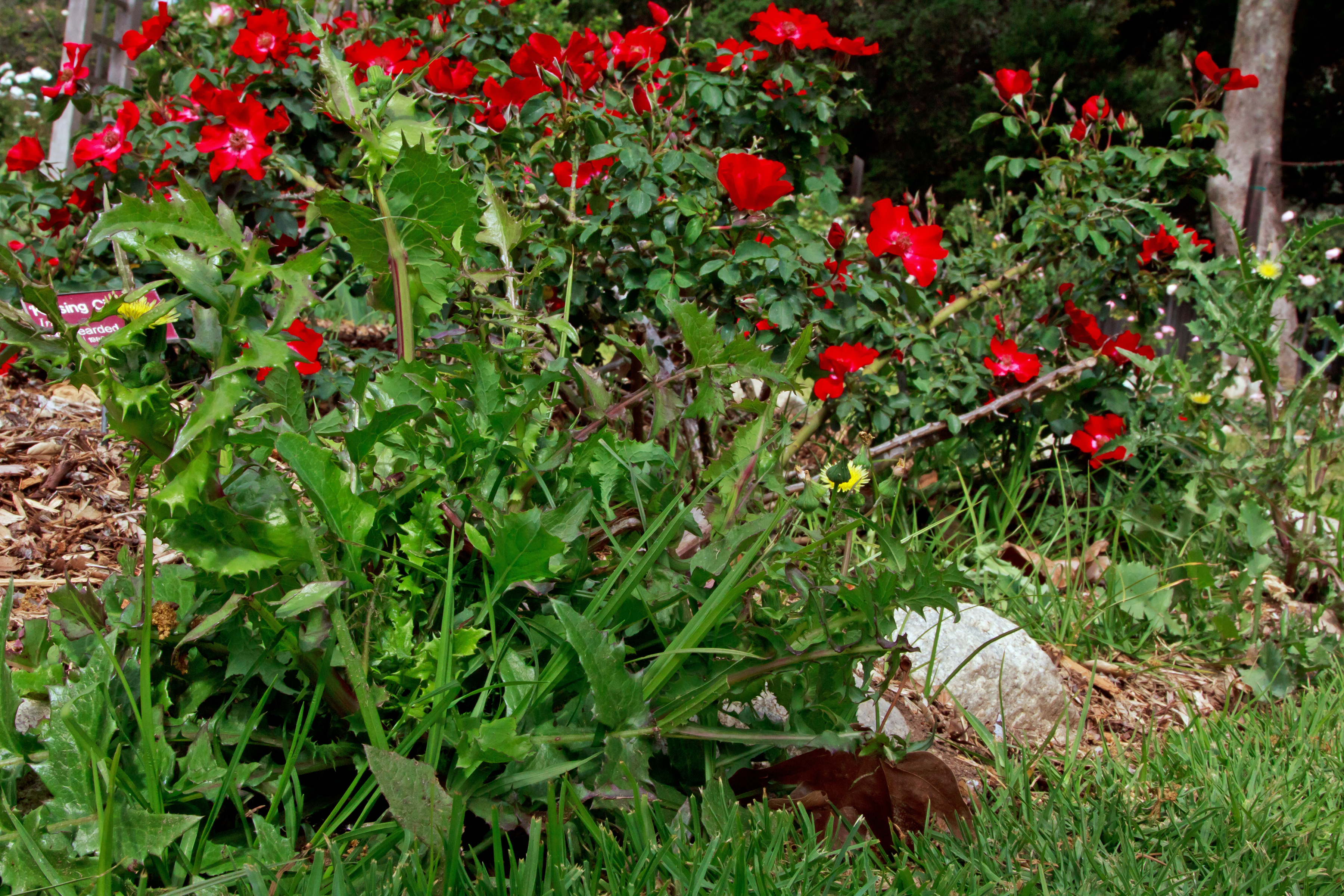
An ACWM (formerly Horticultural Department) employee examines the newly arrived invasive weed, puncturevine, in 1929.
MANAGEMENT OF WEEDS
Management of weeds in Los Angeles County can range from techniques as modest as a few swipes each week with a scuffle hoe in landscaping, to large scale herbicide applications requiring integration of complex chemistries and almost surgical removal of individual invasive weeds in wildland settings.
The following section contains general information on how to manage weeds in landscaping, turf and other areas. In large areas such as right-of-ways, vacant lots and flood control infrastructure, successful management of vegetation can be one of the most challenging missions facing any county department charged with maintaining those areas.
The scale and complexity of the challenges exceed the scope of this general IPM Program. However, with literally decades of experience in abatement, management and eradication of weeds, ACWM is ideally suited to assist departments with this challenge including weed identification and development of management programs.
In many of the western states, the type of damage most closely associated with weeds is probably the severe and, in most cases, irreversible, damage to wildland areas, natural habitat and grazing land. In Los Angeles County, most of the problems caused by weeds fall into one of the following categories:
- Unsightly appearance in landscaping or turf
- Competing for resources (water and nutrients) with desirable plants
- Posing a fire hazard when dry
- Obstructing visibility along roads
- Environmental degradation caused by invasive weeds in watersheds and other sensitive habitat
- Compromised flood control and other infrastructure
With respect to the last category, recent court rulings hold the State* and local agencies** liable for flood related damages which means vegetation encroaching in these areas may not be something that can simply be ignored.
Weeds can be classified into three general categories:
- broadleaves
- grasses
- sedges
Broadleaves are those plants that have wide leaves of various shapes with veins branching out in different directions. Grasses have narrow leaves with parallel veins, arranged in sets of two, and have round or flattened stems. Sedges resemble grasses, but have leaves arranged in sets of three and stems that are triangular in cross section (the old adage “sedges have edges”).
Weeds have three different life cycles as well: annual, biennial, and perennial. Annual weeds complete their life cycle in one year, biennials in two years and perennials survive for many years.
Identifying what type of weeds you are dealing with (often a combination of all of these described here) will allow you to better plan for their management. This information will allow you to anticipate when the weeds you are trying to control will likely germinate, which in turn helps you to time your surveys to look for them and finally can help you to plan your integrated weed management plan. The following table lists many of Los Angeles County’s most common weeds. Almost all of them are exotic invasive which means they did not originate here, and, for a variety of reasons, are able to out-compete native plants in some situations, especially in disturbed areas.
INVASIVE SPECIES ALERT! Appendix K has a list of weeds that are of limited distribution in Los Angeles County, but are known to be, or have the potential to be, extremely destructive. Suspected detections should be reported immediately to ACWM!
LIST OF SOME COMMON WEEDS IN LOS ANGELES COUNTY A= Annual B=Biennial P=Perennial
| Annual bluegrass (A) | English Daisy (P) | Poison hemlock (B) |
| Annual sowthistle (A) | Hairy fleabane (A,B) | Prickly lettuce (A) |
| Arundo (giant reed) (P) | Horehound (P) | Puncturevine (A) |
| Bermuda grass (P) | Horseweed (A) | Purslane (A) |
| Bermuda buttercup (P) | Indian (tree) tobacco (P) | Ragweed (A,P) |
| Blessed milkthistle (A) | Italian thistle | Redstem fillaree |
| Bristly oxtongue (B) | Kikuyugrass (P) | Salt cedar (P) |
| Brome (red, ripgut, California) (A) | Knotweed (A) | Slender thistle (A) |
| Bull thistle (A) | Lamb’s quarters (A) | Smartweed (A) |
| Castorbean (P) | Mallow (cheeseweed) (A) | Sowthistle (A) |
| Clover (black medic and burclover) (A) | Marestail (A) | Spurge (prostrate and creeping) (A) |
| Cocklebur (spiny, common) (A) | Mustard (A) | Sweetclover (A,B,P) |
| Common groundsel (A) | Nettleleaf goosefoot (A) | Telegraphweed (A,P) |
| Crabgrass (A) | Nightshade (A,B,P) | Tocolote (Malta thistle) (A) |
| Creeping woodsorrel (P) | Nutsedge (P) | Tumbleweed (Russian thistle) (A) |
| Curly dock (P) | Perennial pepperweed (P) | White clover (P) |
| Dallisgrass (P) | Pigweed (A) | Wild oat (A) |
| Dandelion (P) | Plantains (P) | Wild radish (A) |
Almost all of the weeds on the table above are non-native.
* Paterno v. State of California 2003
** Arreola v. Monterey County 2002


